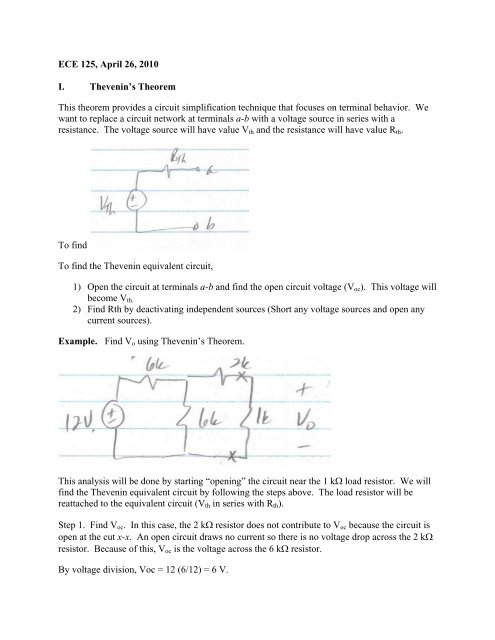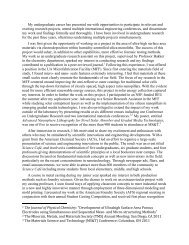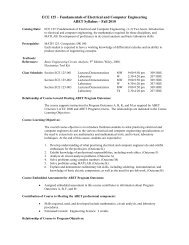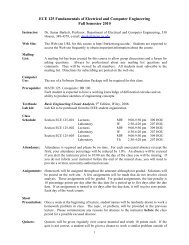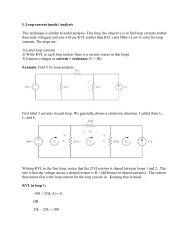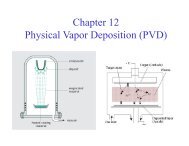ECE 125, April 26, 2010 I. Thevenin's Theorem This theorem ...
ECE 125, April 26, 2010 I. Thevenin's Theorem This theorem ...
ECE 125, April 26, 2010 I. Thevenin's Theorem This theorem ...
Create successful ePaper yourself
Turn your PDF publications into a flip-book with our unique Google optimized e-Paper software.
<strong>ECE</strong> <strong>125</strong>, <strong>April</strong> <strong>26</strong>, <strong>2010</strong>I. Thevenin’s <strong>Theorem</strong><strong>This</strong> <strong>theorem</strong> provides a circuit simplification technique that focuses on terminal behavior. Wewant to replace a circuit network at terminals a-b with a voltage source in series with aresistance. The voltage source will have value V th and the resistance will have value R th .To findTo find the Thevenin equivalent circuit,1) Open the circuit at terminals a-b and find the open circuit voltage (V oc ). <strong>This</strong> voltage willbecome V th.2) Find Rth by deactivating independent sources (Short any voltage sources and open anycurrent sources).Example. Find V o using Thevenin’s <strong>Theorem</strong>.<strong>This</strong> analysis will be done by starting “opening” the circuit near the 1 kΩ load resistor. We willfind the Thevenin equivalent circuit by following the steps above. The load resistor will bereattached to the equivalent circuit (V th in series with R th ).Step 1. Find V oc . In this case, the 2 kΩ resistor does not contribute to V oc because the circuit isopen at the cut x-x. An open circuit draws no current so there is no voltage drop across the 2 kΩresistor. Because of this, V oc is the voltage across the 6 kΩ resistor.By voltage division, Voc = 12 (6/12) = 6 V.
Step 2. Find R th. Shorting the voltage source yields the circuit below:Shorting the 12 V source places the two 6 kΩ resistors in parallel (3 kΩ) and that combination isin series with 2 kΩ. R th is equal to 3 kΩ + 2 kΩ = 5 kΩ.The circuit network to the left of the cut x-x can be replaced by the Thevenin equivalent (6 V inseries with 5 kΩ). The “load” resistance (1 kΩ) can now be attached to the equivalent circuit.By voltage division,V o = 6* ( 1 kΩ)(5 kΩ + 1 kΩ)= 6(1/6) = 1 V.II.Maximum Power TransferThevenin equivalent circuits are useful in determining the maximum power that can be deliveredto a load. In a simple series Thevenin equivalent circuit, the power delivered to the load is givenby:P L = i 2 * R LIt is useful to determine the value of R L that willmaximize the quantity of power delivered to aload resistance. <strong>This</strong> maximum value can bedetermined by differentiating P L with respect to R L and setting the derivative equal to zero. Thederivation will be shown to you in <strong>ECE</strong> 225. Setting dP L /dR L = 0 results in R s = R L . R s issimply the resistance we have been calling R th .
Another example.For the following network, find RL for maximum power transfer as well as the maximum powertransferred to this load.Step 1. Find V ocRemove the load resistance by opening the circuit just to the left of the load and determining V oc .V oc is the voltage across the 4 kΩ resistor. Doing a source transformation of the 4 mA sourceand the series resistance (2+1 kΩ = 3 kΩ) yields a 12 V source in series with the 3 kΩ:By voltage division, V oc = 12 * (4k) = 12* (4/9) = 16/3 V.(4k + 3k + 2k)Step 2. Find R thOpen the 4 mA source and determine R th at the place that you “opened” the circuit (this is notthe same place that you are opening the 4 mA source).In this circuit, 5 kΩ (2 + 1 + 2) is in parallel with 4 kΩ leading to R th = 20/9 = 2.22 kΩ.
Putting this all together…We set the load resistance = 2.22 kΩ for maximum power transfer and now can calculate P L.P L = I 2 R L and I = 5.33(2.22+2.22) kΩSo= 1.2 mAP L = (1.2 mA) 2 (2.22 kΩ) = 3.2 mW.You could also calculate P L by using the equation V L 2 /R LAnother example.Problem E5.7 from the text. Find R L for maximum power transfer and find P maxTo find V oc , open the circuit at a-b and note that V oc is the voltage across the 12 kΩ resistorbecause the 2 kΩ resistor is connected to the open circuit. In this case, V oc = 6 (12/18) = 4 V.Shorting the 6 V source puts the 6 kΩ and 12 kΩ in parallel and that combination is in serieswith the 2 kΩ.
So R th = 4 kΩ + 2 kΩ = 6 kΩ yielding the circuit below:P max = 0.667 mW


